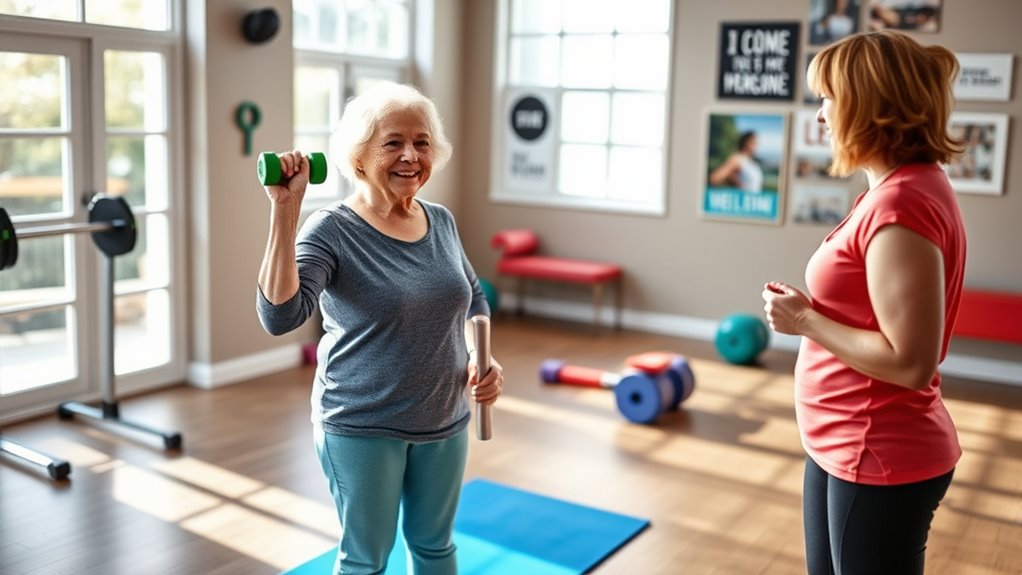Weight training can greatly enhance your quality of life as you age. It helps combat muscle loss and boosts bone density, reducing the risk of fractures. You’ll also improve your balance and mobility, making daily tasks easier. Bodyweight exercises are a great starting point, gradually progressing to dumbbells as you build strength. Staying committed to regular workouts can lift your mood and lower stress. Discover more ways to maximize your strength training journey and its benefits.
Key Takeaways
- Strength training helps combat muscle mass loss and improves overall physical function in seniors.
- Regular workouts enhance bone density, reducing the risk of osteoporosis-related fractures.
- Engaging in weight training boosts mental health and emotional well-being among older adults.
- A commitment to strength exercises improves balance and mobility, lowering fall risks.
- Incorporating bodyweight and light dumbbell exercises fosters safe progression and strength development.
Benefits of Strength Training for Seniors

As you age, incorporating strength training into your routine can greatly enhance your quality of life.
For older adults, regular strength training helps counteract muscle mass loss, known as sarcopenia, which accelerates after age 60. By engaging in consistent workouts, you can considerably improve bone density, reducing the risk of osteoporosis-related fractures, particularly important for postmenopausal women. Additionally, maintaining a balanced diet tailored to your nutritional needs can further support your strength training efforts. Research suggests that foods rich in omega-3 fatty acids can enhance muscle health and recovery. Furthermore, engaging in consistent physical activity can help mitigate the chronic feelings of emptiness often experienced by those with BPD. Engaging in strength training also promotes emotional well-being, which is essential for overall mental health.
Strength training also enhances functional movements, making everyday tasks like climbing stairs or carrying groceries easier and safer.
Additionally, it’s been shown to improve mental health by alleviating symptoms of stress, anxiety, and depression. Furthermore, engaging in strength training can provide significant financial considerations for elderly care by reducing the need for extensive medical treatments related to mobility issues.
The CDC recommends that you engage in strength training at least twice a week to reap these benefits and support your overall health and fitness.
Getting Started With Bodyweight Exercises

Incorporating bodyweight exercises into your routine is a fantastic way to kick off your strength training journey. These movements help you learn proper form while building a solid strength foundation. Aim for three sets of 10 to 15 repetitions to guarantee effectiveness and minimize injury risk. Themed breakfasts can also be a great way to foster social interaction and community engagement, much like group workouts. Engaging in hands-on learning through physical activities can further enhance your understanding of movement mechanics. Additionally, considering your nail shapes can also be a fun way to express your personality while engaging in fitness activities. It’s essential to ensure that you are hydrated before and during your workouts to support optimal performance.
| Common Bodyweight Exercises | Benefits |
|---|---|
| Squats | Enhance overall strength |
| Incline pushups | Improve upper body stability |
| Dead bug | Strengthen core muscles |
As you get comfortable, gradually increase the intensity of your workouts. Scheduling your exercise program on non-consecutive days to allow for recovery is essential for promoting regular veterinary check-ups and enhancing strength while maximizing the benefits of strength training, leading to better overall fitness.
Transitioning to Dumbbells: Choosing the Right Weights

Changing to dumbbells can elevate your strength training routine, providing more resistance and variety than bodyweight exercises alone.
When choosing weights, start with light weights that allow you to perform 8-12 repetitions comfortably while still challenging your muscles. This approach helps you avoid injury and maintain proper form. Engaging in strength training can also promote good grief by helping to alleviate stress and improve overall mental health. Additionally, practicing user privacy is crucial when using any fitness apps that may track your workouts. Strength training not only builds muscle but also can enhance your credit score by improving overall physical health and well-being. Incorporating sustainable fashion principles into your workout gear can also promote eco-friendly practices while exercising.
Aim to access three different weights for a well-rounded workout targeting various muscle groups. As your body gets stronger, gradually increase the weight, ensuring you can still perform three sets effectively.
Regularly reassess your choices, looking for a weight that tires your muscles after 12-15 repetitions. By following these guidelines, you’ll enhance your strength training experience and support better overall health. Additionally, incorporating multi-functional furniture can further assist in creating a dedicated workout space that maximizes your home environment.
Recommended Strength Exercises for Older Adults

Now that you’ve chosen the right dumbbells, it’s time to focus on recommended strength exercises that can benefit older adults.
Start with bodyweight exercises like squats and incline pushups to learn proper form. As you progress, incorporate seated rows and stationary lunges using light dumbbells for 10 to 15 repetitions. Engaging in strength training can also help reduce the risk of breast cancer as it promotes overall health and wellness. Additionally, maintaining a consistent sleep routine can support recovery and overall well-being during your strength training journey. Implementing robust fraud detection measures in your routine can also ensure safety and security while managing your health. Furthermore, regular strength training can enhance open floor plans in your living space, creating a more inviting atmosphere for both exercise and relaxation.
Begin with bodyweight exercises like squats and incline pushups to master form, then add light dumbbells for seated rows and lunges.
The dead bug is another great addition to strengthen your core. Aim for strength training at least twice a week, with sessions lasting 10 to 15 minutes if you’re new to resistance training. Engaging in regular strength training can also help improve overall hearing health, which is crucial for maintaining an active lifestyle as you age.
Remember to allow at least 24 hours of rest days between workouts targeting the same muscle groups. This balance is essential for building strength and maximizing the benefits of your efforts.
The Importance of Regular Commitment to Strength Training

Here’s why a regular commitment matters:
- Improved muscle strength that combats age-related decline
- Enhanced balance and mobility, reducing the risk of falls
- Increased recovery time awareness, allowing your body to adapt safely
- Lower stress levels, promoting mental well-being
- Engaging in physical activity, such as yoga for back pain, can complement strength training and enhance overall flexibility. Additionally, maintaining a balanced diet rich in fruits and vegetables can support muscle health and overall strength.
Frequently Asked Questions
What Is the Best Weight Lifting Routine for Seniors?
To find the best weight lifting routine for seniors, you should start with two to three sessions each week.
Focus on major muscle groups with exercises like squats, lunges, and overhead presses. Use lighter weights for 8-12 repetitions, gradually increasing as you gain strength.
Incorporate a mix of upper and lower body exercises, aiming for three sets of 10 to 15 reps each.
Remember to rest for 48 hours between sessions for ideal recovery.
Should a 70 Year Old Do Strength Training?
Imagine your body as a sturdy tree, growing stronger with each passing season. At 70, you should definitely embrace strength training.
It helps fortify your branches against the winds of aging, enhancing muscle mass and improving bone density. By engaging in strength exercises twice a week, you’ll nourish your roots, boosting both physical and mental health.
Start with simple movements, and watch your confidence flourish as you cultivate a healthier, more resilient you.
Can a 70 Year Old Regain Muscle Tone?
Yes, you can definitely regain muscle tone at 70!
Engaging in consistent strength training can help you build strength and improve muscle definition. Aim for at least two sessions a week, starting with bodyweight exercises before gradually adding light weights or resistance bands.
Focus on your form to prevent injuries and boost your confidence. With dedication, you’ll notice improvements in your muscle tone and overall strength, enhancing your daily activities.
What Is the 6 12 25 Rule?
The 6-12-25 Rule is a game-changer for your strength training routine!
It suggests you perform 6 sets of 12 repetitions in 25 minutes, focusing on moderate to heavy weights. You’ll push your muscles to fatigue, promoting growth and strength.
Each rep should be done with perfect form, and as you get stronger, gradually increase the weight.
This efficient approach not only boosts your strength but also enhances your overall fitness in no time!
Conclusion
Incorporating strength training into your routine can be a game-changer, enriching your life with energy and resilience. By embracing this journey, you’re not just lifting weights; you’re lifting your spirits and enhancing your independence. As you gracefully navigate this new chapter, remember that consistency is key. With each session, you’re investing in a brighter, more active future. So, let’s celebrate the strength you cultivate, transforming challenges into opportunities for growth and well-being.









